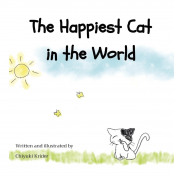
LitPick Review
The Happiest Cat in the World is a simple picture book with an important message. Throughout the book, the cat shares its ideas of freedom, including finding its own food, making shelter, and having kittens. The cat leads a supposed happy life, repeating “whenever I want, as much as I want”, with no fear of these freedoms being taken away. When paired with the author’s explanation of the book, the reader will learn that these ideas of freedom are only dreams, rather than reality.
Opinion:
Chiyuki Krider’s picture book, The Happiest Cat in the World, uses very simple illustrations and short, repetitive text. These features make the book appealing to younger readers. The content, however, is geared toward older children. To comprehend the author’s message, the reader will need to make inferences throughout the book. For instance, the cat depicted has a clipped ear, indicating that it is spayed or neutered, yet still dreams of having kittens, which is not possible. The message here is a bit convoluted, and may be confusing to children. Without the author’s note at the end of the book, I feel the message falls short.
The illustrations in the book show the cat being free, which pairs nicely with the text. However, these illustrations appear to show the cat living independently, providing its own food and shelter. What I found confusing was whether or not the author was implying that housing cats as pets is considered taking away these freedoms, as a cat kept in captivity will not hunt or find its own shelter. Additionally, spaying and neutering animals is a common practice to help maintain stray cat populations, and the well-being of domestic cats; neither of which is intended to harm the cat. At the end of the book, the cat is illustrated in a gray, rainy scene, where the reader is likely to infer the cat is unhappy. But, is this what the cat wanted all along—to be on its own? Or does it want to be in a loving home? Ultimately, the book encourages the reader to think about animals’ needs and their well-being, which is always an important theme, but the overall message, in my opinion, remains unclear.

